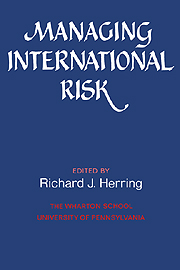 Managing International Risk
Managing International Risk Published online by Cambridge University Press: 07 May 2010
Introduction: clarifying terms
We live in a period of high uncertainty, some would say exceptional uncertainty. John Kenneth Galbraith has called it the “Age of Uncertainty.” The purpose of this chapter is to assess the risks, or one might better say, the threats, to the international economic system that arise from this uncertainty, and the suitability of present institutional arrangements to deal with those risks.
By “risk” I mean the possibility of an unforeseen development that influences our welfare. Risk as used here bears little relationship to the risk involved in games of chance, where the outcome is uncertain before the dice are rolled, but the nature of the outcomes is understood and their relative likelihood, or probability, is known. One might say there is statistical certainty in games of chance. In sharp contrast, the principal effort to deal with risk in social systems, as with hang gliding, is to try to influence the probabilities.
If the development is foreseen, it can be allowed for and is not a risk. For the most part, we will be dealing with unforeseen adverse developments. Favorable developments are generally of less concern, although in some cases, if they are mishandled, they may influence the future adversely, as when a firm finds itself with demand for its products that it cannot satisfy and thereby loses customers, or a country discovers oil, which creates public expectations it cannot satisfy.
To save this book to your Kindle, first ensure [email protected] is added to your Approved Personal Document E-mail List under your Personal Document Settings on the Manage Your Content and Devices page of your Amazon account. Then enter the ‘name’ part of your Kindle email address below. Find out more about saving to your Kindle.
Note you can select to save to either the @free.kindle.com or @kindle.com variations. ‘@free.kindle.com’ emails are free but can only be saved to your device when it is connected to wi-fi. ‘@kindle.com’ emails can be delivered even when you are not connected to wi-fi, but note that service fees apply.
Find out more about the Kindle Personal Document Service.
To save content items to your account, please confirm that you agree to abide by our usage policies. If this is the first time you use this feature, you will be asked to authorise Cambridge Core to connect with your account. Find out more about saving content to Dropbox.
To save content items to your account, please confirm that you agree to abide by our usage policies. If this is the first time you use this feature, you will be asked to authorise Cambridge Core to connect with your account. Find out more about saving content to Google Drive.